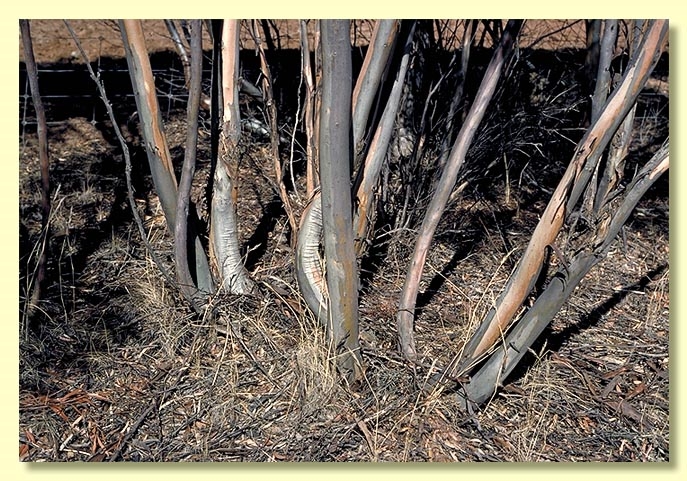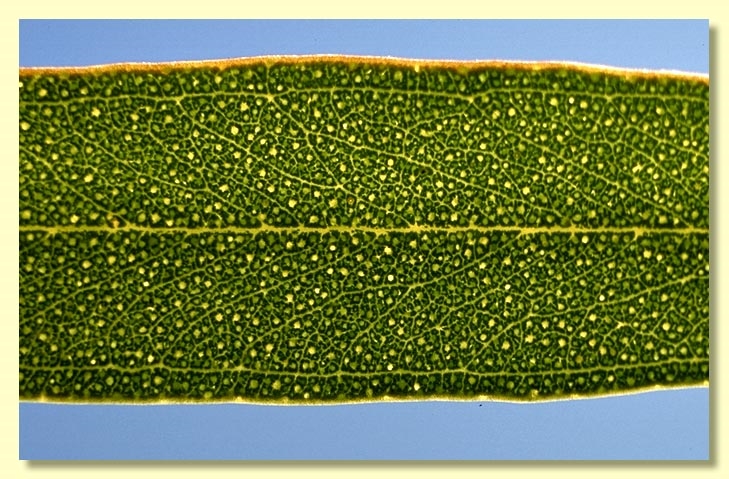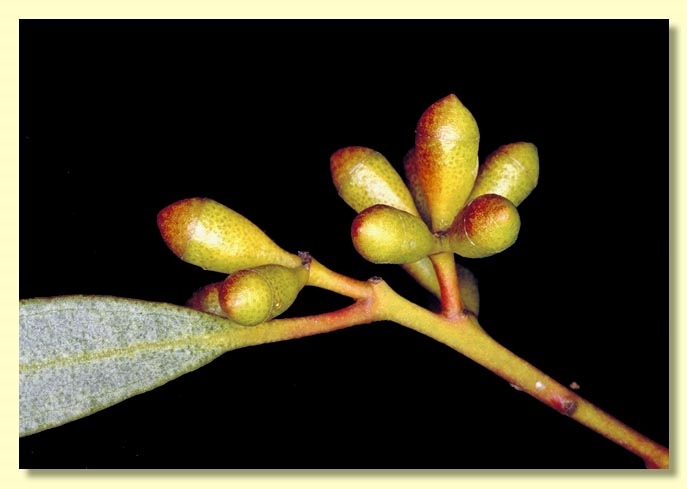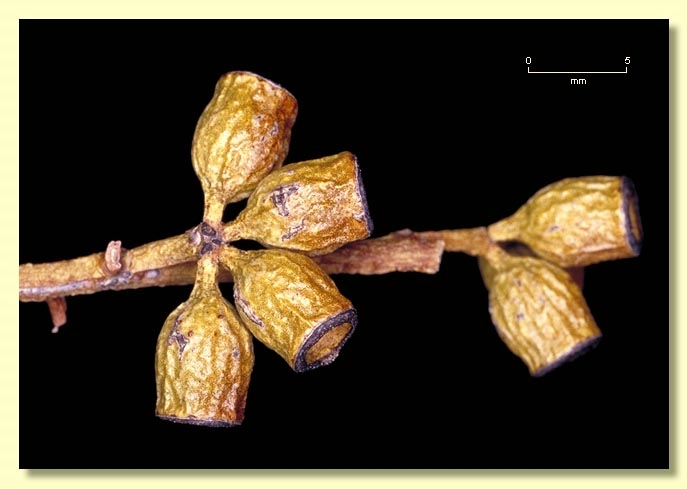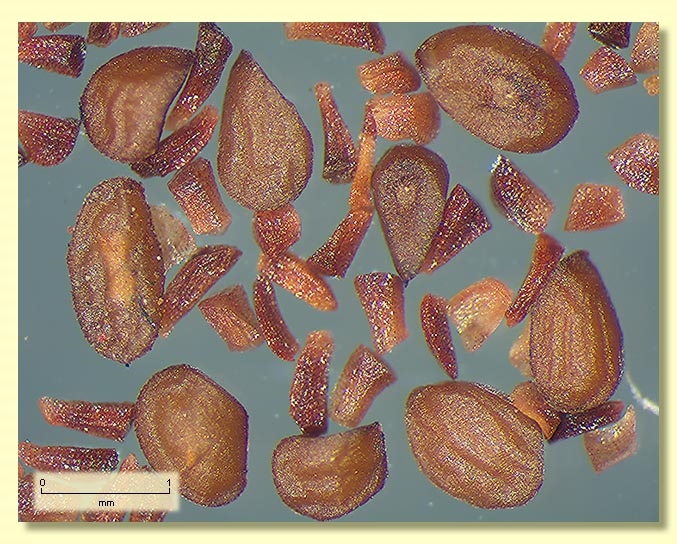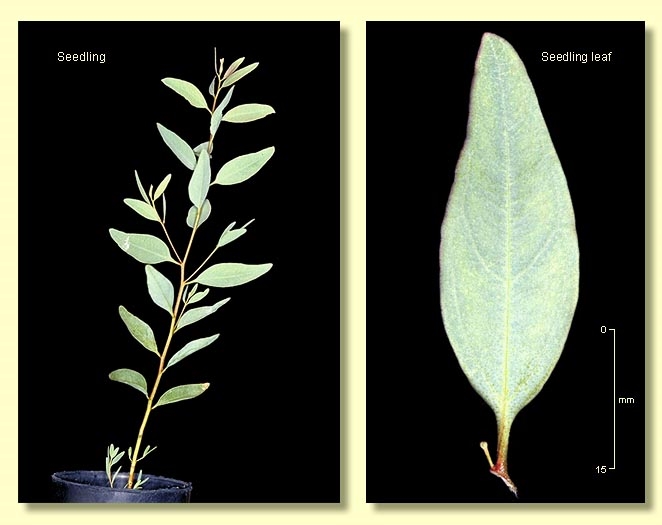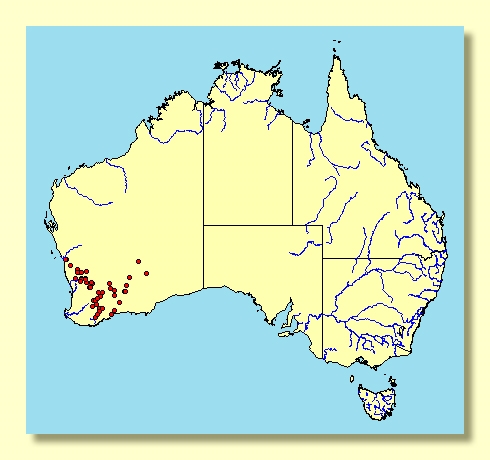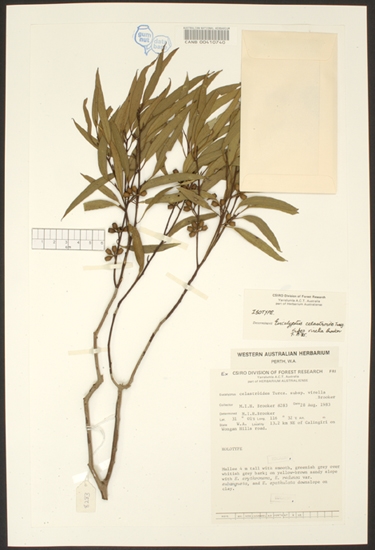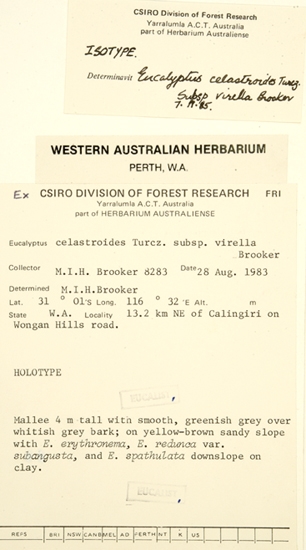Eucalyptus | Symphyomyrtus | Bisectae | Destitutae | Heterostemones
Euclid - Online edition
Eucalyptus celastroides subsp. virella
Bark rough and flaky grey-brown for up to half of trunk then smooth, or smooth over whole stems, mottled whitish and pink-grey to salmon.
Branchlets never glaucous; lacking oil glands in the pith.
Juvenile growth (coppice or field seedlings to 50 cm): stems rounded in cross-section; juvenile leaves always petiolate, opposite for 1 or 2 nodes then alternate, ovate to lanceolate, 2–4 cm long, 1.5–2.5 cm wide, green, more or less glossy.
Adult leaves alternate, petioles 0.4–1.5 cm long; blade narrowly lanceolate to linear, (4.2)5–8(9.5) cm long, 0.4–1.5 cm wide, base tapering to petiole, margin entire, apex pointed, concolorous, green, usually glossy, side-veins very acute to almost parallel at the base of the leaf, reticulation sparse to moderate, intramarginal vein remote from margin, oil glands island and intersectional, irregularly shaped.
Inflorescence axillary unbranched, peduncles 0.3–1 cm long, buds 7 per umbel, pedicels 0.1–0.4 cm long. Mature buds narrowly pyriform to obovoid (0.5–0.8 cm long, 0.2–0.4 cm wide), often square in cross-section lower on the hypanthium, scar present (outer operculum shed early), operculum rounded and apiculate to conical (0.15–0.3 cm long), stamens inflexed or the long outer filaments irregularly disposed, outer filaments barren (staminodes), inner stamens shorter, always fertile, anthers oblong-reniform to ± spherical, scarcely versatile, sub-basifixed, dehiscing by sub-terminal pores, style long and straight, tapering near the base, stigma rounded, locules 3 or 4, the placentae each with 4 vertical rows of ovules. Flowers white.
Fruit pedicellate (pedicels 0.1–0.4 cm long), urceolate to barrel-shaped (usually narrowing to a short neck immediately below the rim) and sometimes four-angled, 0.5–0.8 cm long, 0.4–0.5 cm wide, disc descending vertically, valves 3 or 4, enclosed.
Seeds tan, 0.7–2 mm long, flattened-ovoid, dorsal surface more or less smooth, hilum ventral.
Cultivated seedlings (measured at node 10): cotyledons Y-shaped (bisected); stems rounded or square in cross-section, warty or smooth; leaves always petiolate, opposite for 4 to 7 nodes then becoming alternate, ovate to lanceolate, 4–7 cm long, 1–2 cm wide, dull, green.
Flowering has been recorded in August, September, October, November and December.
Eucalyptus celastroides is a small mallee species endemic to Western Australia, found in the northern, central and southern wheatbelts, and central goldfields east of Perth. Smooth-barked or partly rough-barked with slightly glaucous adult leaves weathering to green, or adult leaves always green.
It belongs in Eucalyptus subgenus Symphyomyrtus section Bisectae subsection Destitutae because buds have two opercula, cotyledons are Y-shaped and branchlets lack oil glands in the pith. Within this subsection E. celastroides is one of seven closely related species that form series Heterostemones. This series is characterised by the barren outer stamens that are conspicuously twisted and spreading in flower and the much shorter fertile inner stamens that are held more erect. Species in series Heterostemones also have fruit with a descending disc and enclosed valves while the leaves have side-veins quite acute at the base of the lamina and usually sparse reticulation.
E. celastroides is distinguished from other species in series Heterostemones by having buds and fruit that are only four-angled basally, otherwise being rounded in cross-section. Of the other six species in the series E. calycogona, E. prolixa and E. quadrans all have buds and fruit that are square in cross-section whilst E. gracilis, E. brevipes and E. yilgarnensis all have buds and fruit rounded in cross-section. In addition E. gracilis and E. quadrans have a short rounded to flattened operculum (conical to rounded in E. celastroides), E. yilgarnensis has the long slender pedicels and the short rounded opercula, and E. brevipes has the cupular or cylindrical fruit (usually urceolate in E. celastroides).
The glossy green-leaved mallees of series Porantherae may be confused on fruit characters with species in series Heterostemones, but the fruits of species in series Porantherae are thick-rimmed while those in series Heterostemones are thin-rimmed.
There are two subspecies:
E. celastroides subsp. celastroides
Occurs through the goldfields from Kellerberrin, Bullfinch and Comet Vale south-east to Marvel Loch and Norseman and east almost to Balladonia and Coonana. It is often an understorey plant in taller mallee scrub, and is distinguished from subsp. virella by rough basal bark, the greyish crown, glaucous juvenile leaves and glaucous buds.
E. celastroides subsp. virella
Occurs in the central and northern wheatbelts and the northern part of the southern wheatbelt from Gnowangerup north to Three Springs and east to Beacon extending into the goldfields to the area between Burra Rock, Coolgardie and north of Kalgoorlie. It differs from subsp. celastroides by the smooth bark, the glossy green adult leaves, and it has no parts glaucous.


